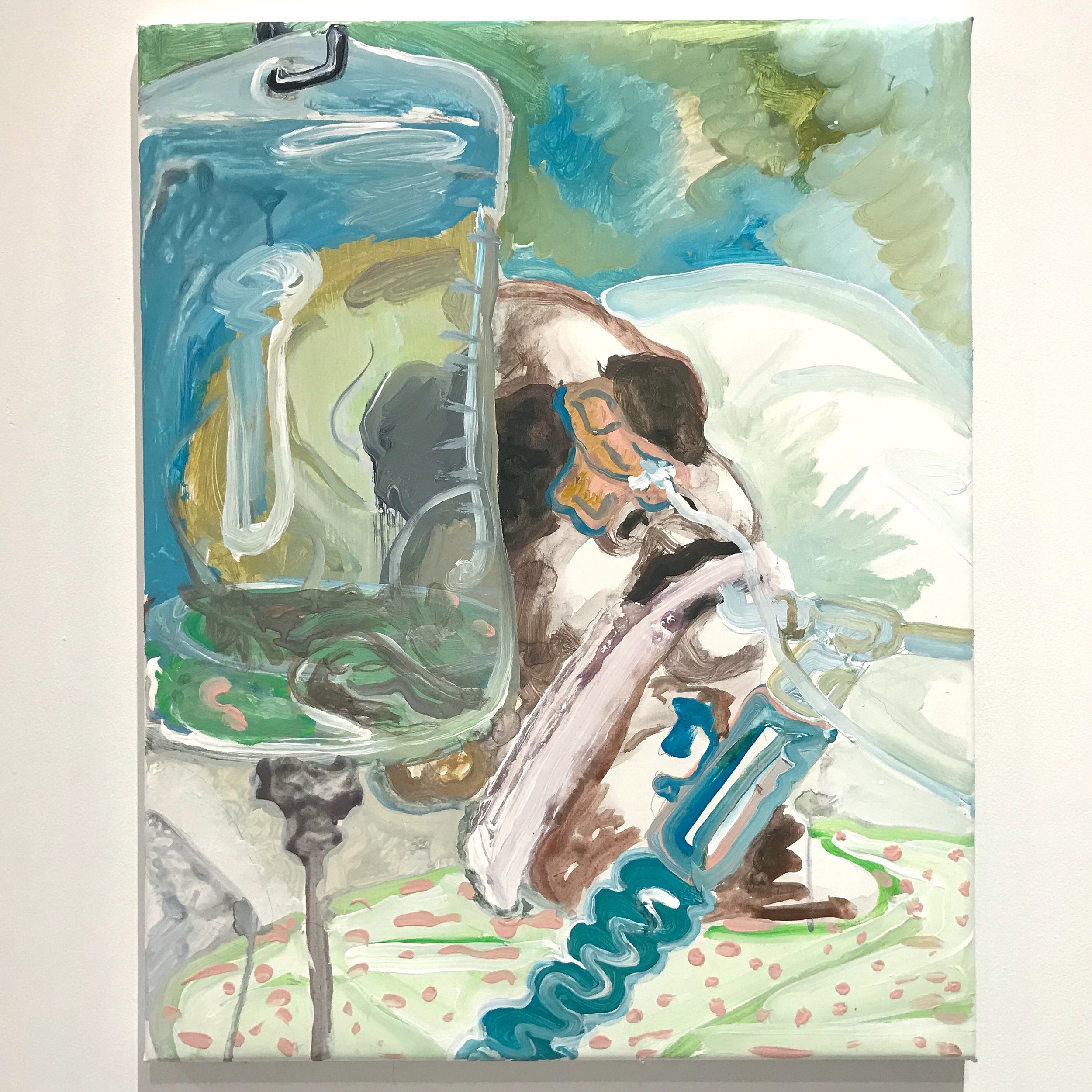THE NOSE:
Mala Iqbal
Matt Miller
Bridget Mullen
Lindsay M Burke
Paul Birbil
Scott Grodesky
Philip Hinge
Bianca Kann
Frank Holliday
April 20, 2018 - May 6, 2018
THE NOSE APRIL 20 — MAY 6, 2018 OPENING: FRI APRIL 20, 7-9 GEORGE GALLERY is pleased to present THE NOSE, a group exhibition with works by MALA IQBAL, MATT MILLER, BRIDGET MULLEN, LINDSAY M. BURKE, BIANCA KANN, FRANK HOLLIDAY, SCOTT GRODESKY, PHILIP HINGE, and PAUL BIRBIL. The exhibition will open on Friday, April 20, with a reception from 7 to 9 pm at 117 Grattan Street #222 in Brooklyn. GEORGE GALLERY is open Saturdays and Sundays from 1 to 5 pm and by appointment.
———
Displacement provokes anxiety. Two weeks ago the New York Times published “The ISIS Files,” documenting the bureaucratic reach of the Islamic State in a painstakingly detailed examination of ISIS’s administrative documents, many discovered after militants released their grip on Mosul, their last major territory to fall. The Times’s focus on quotidian ephemera and documents, property contracts, for instance, highlighted ISIS’s tightly centralized administrative control — interdepartmental red tape surrounding acts of bloody cruelty.
Since 2014, ISIS’s systematic rampage of various mosques, museums, libraries, and archaeological sites has been well-documented. A 2015 recording shows members of ISIS dismantling entire galleries of ancient statuary inside the Mosul Museum, using their bare hands and hammers to wrench statues off pedestals before attacking the smashed remains. Documenting a brutal iconoclasm against Iraq’s rich cultural heritage, the video’s final seconds reveal a multistory gallery, empty but for rubble and debris scattered across hard floors. If, as Francis Bacon noted in 1605, “antiquities are history defaced,” then what to make of history, when the antiquities are themselves defaced. To deface, then, can be defined, “to mar the face, features, or appearance of; to spoil or ruin the figure, form, or beauty of, or to disfigure,” but these inadequately express the significance of the face as a locus of real and symbolic attention, and, among the living, where our most important sensory organs are found, those through which we take in and react to the world around us.
The anxiety of displacement is explored in Nikolai Gogol’s “The Nose,” in which the violent act of defacement is not described, but rather a given state from which the author explores the surreal and seemingly interminable difficulties experienced by his protagonist, Kovalyov, who wakes one morning to find “a perfectly flat patch of skin” where his nose should be. Concerned with appearance in every sense, Kovalyov worries foremost about the effects of his disfigurement on his professional prospects in St. Petersburg. Yet Kovalyov’s preoccupation with finding and replacing his nose is not as surprising as Gogol’s ability to transform his character’s obsession into a comical study of social ambition and class consciousness. For the author, ‘defacing’ Kovalyov has everything to do with form — including the unusual form of the story itself.
Gogol concludes “The Nose” by stepping back from an otherwise straightforward account of events to offer comments on the unbelievable story preceding it; the story he told. Gogol asks how any author could imagine such a fantastic tale:
“I confess this is utterly incomprehensible, it is simply … no, no I cannot conceive of it at all. […] And yet, for all of that, we can, of course, concede the possibility of it in certain, minor respects, first one, then another, a third, and so forth … and after all, do we not encounter incongruities everywhere in life? And besides, once you reflect on it, somehow, there is something to all of this. Say what you will, but things of this kind do take place in the world—rarely, but they do.”
The ‘senselessness’ of it all gives way to Gogol’s bemused (if resigned) acknowledgement that, on reflection, strange things do happen. In this way, Kovalyov’s “flat patch” can be compared to John Locke’s description of the mind as a tabula rasa, or blank sheet, with the capacity — through sensation — to form complex thought and behavior. The strange thing might be just how hopelessly reduced the protagonist feels, and is. In its absence, Kovalyev’s nose comes to represent not just a single problem he faces, but brings about every problem he has ever, and could ever imaginably experience. If his disfigurement were righted, then all would be right once more. Then, by disfiguring Kovalyov, Gogol suspends the reader’s usual mode of reading a story. In the end, he asks us to confront the interruption, “once you reflect on it…” That is, there exist events that take place and are unbelievable to those who are caught up in them, “incongruities everywhere in life” that ruin a story, or make one.
There are other ways to convey the exigencies of disfigurement, defacement, destruction, and dislocation, apart from the examples given above. The recent works by the artists included in this group demonstrate the variety of such practices. Certain works feature disembodied forms — some organs, or organ-like — juxtaposed in ambiguously synthetic environs. Distortions and transformations made to ‘conventional’ portraiture indicate not only the possibilities of turning the known strange, but also the limits of articulating to what ‘convention’ really refers. Chemical and physical reactions performed on everyday materials create empathetic works, at the same time rendering their constituent media inscrutable. Scenes with unfamiliar perspectival schema distance us from usual modes of representation, but bring us closer to the subjects depicted and the artist at work. The work on display shows the artists’ shared interest in deliberate contortions — but the anxiety they provoke is one of remarkable playfulness, tenderness, and intimacy. They disarm. Certainly, then, “there is something to all of this.”
The artists live and work in New York. For more information: george-gallery.com, malaiqbal.com, instagram: @emptymart, bridgetmullen.com, lindsaymburke.com, biancakann.com, frankholliday.net, instagram: @scott.grodesky, phinge.net, instagram: @paulbirbil.
Tyler Coulton








